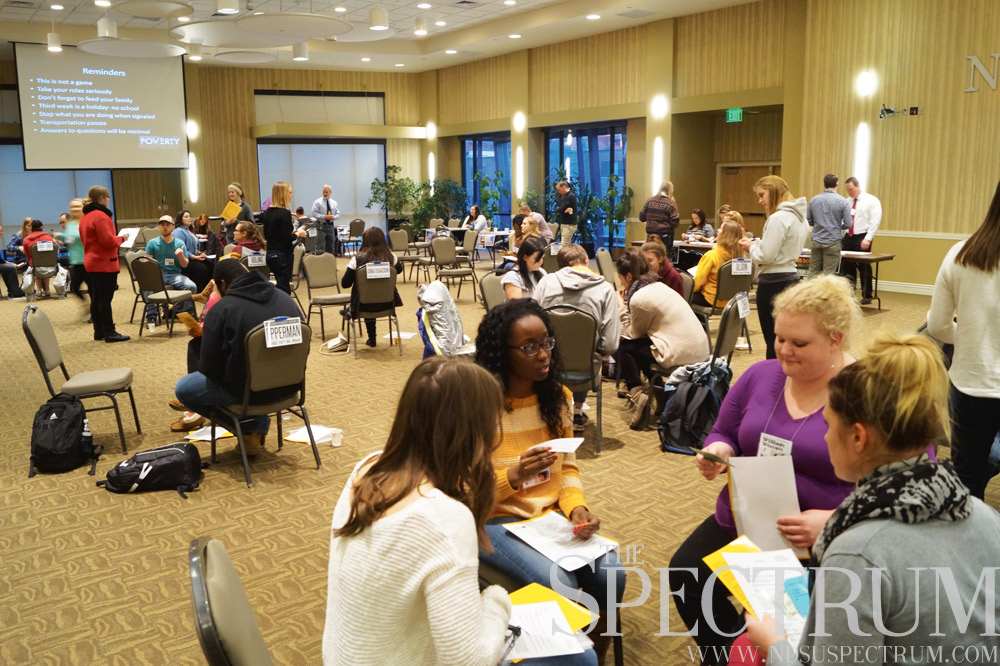
Students struggle to make ends meet during the poverty simulation.
Students participating in the NDSU Poverty Simulation were given one main guideline: This is not a game.
Grouped into “families,” students received character and family background information in a packet. They were asked to fill those roles accordingly, whether it included a screaming hungry baby, a pregnant sixteen-year-old or an unemployed grandfather. Additional details about available resources set up around the room were given.
Then, they were set loose to figure out how to survive.
Hailey Goplen, the coordinator of the event said in her opening speech, “This may feel chaotic, but that is homelessness — frequently feeling lost and a bit confused.”
The simulation took place this Thursday night in the Plains Ballroom, with about 60 students in attendance to learn the hard way about what living in poverty really entails. Four weeks, each accounted for in 15 minute increments, made up the simulation time. Between each week, families were allowed to congregate and come up with a game plan to survive the oncoming week.
At the beginning, students had positive dispositions and lighthearted outlooks. As it went on, an almost tangible shift occurred in the atmosphere to one of irritation, stress and hopelessness. Walking throughout the room, overheard conversations frequently ending in, “We’ll figure it out later.”
Fourteen resources available to the students included everything from an employment agency and social services to a pawn shop and law enforcement officer. Basic necessities like a bank, childcare center, school and grocery store were also provided.
While it sounds like a lot of help surrounding their predicament, a catch existed. Like in the real world, not all entities were out to improve or help the greater good, and those frequently did not have enough available resources to do so. Many students spent precious minutes waiting in line to get assistance, only to be turned away due to no health insurance, lack of funds to give them extra transportation passes or other contingencies that were part of their situation and out of their control.
On top of this, students needed transportation passes to get everywhere; without one, they would be turned away. So, if a family had no passes, they had no way to reach resources and no way to make money, keep jobs, apply for benefits or buy food. At this point, they resorted to illegal means such as stealing or selling drugs or other goods illegally on the street. This led to them spending time in jail, which cost their families more money in bail, and a vicious cycle began.
One word can best describe the simulation: desperation. Parents desperately tried to bargain a good price for their cars at the pawn shop, only to be cheated by a dealer who understood their hopeless situation. Unemployed workers desperately applying for jobs were turned away due to past circumstances. The list goes on.
Time was lacking in every instance. Children spent 7 of the 15 minutes in school, while anyone with a full-time job spent 7 at their place of employment. Those without jobs spent time filling in job and social security applications, buying food using any remaining cash and talking with a community action agent who did not have any transportation passes left to give them. All of these necessities for survival took time away from planning.
If the reality of poverty was not hitting hard enough, students were also given “Stroke of Fate” cards. These symbolized those problems in life that cannot be controlled, like illness or crime. Sometimes they contained good news, like a measly $25 lottery win or some additional money back from the bank. Students rejoiced at the small fortune and plotted where the money could be used to best fill their needs. But, punctuating these small victories were still utterances of “this is really stressful,” and “I don’t know what we should do.”
Between each week, agencies stopped by with not-so-gentle reminders to pick children up from childcare, pay mortgages or risk foreclosure and to buy food because their families were undernourished. Families tried to stretch each dollar to keep their homes and the lights on, but some weeks they had to make a decision between this or feeding their hungry families.
As the whistle blew signaling the end of the simulation, students sat back and sighed, relieved to go back to their real lives. But what the simulation really showed was that sitting back is not an option for some.
And while it is easy to pretend these situations were just a simulation, the families and their stories were based on real families who had sought help. And these situations were of an average level of poverty.
Goplen gave the facts at the start, but the reality hit at the end:
- 8 million Americans were living below the poverty line in 2013.
- For a family of four, the poverty line is a total income of $24,250. Anything above disqualifies a family from many forms of assistance.
- A family of five must make below $28,410, and a family of 6 less than $32,570.
- In Minnesota, 11.2% of the population are below this line.
- In North Dakota, 11.8% are below it.
Because we frequently overlook statistics in our desensitized world, the simulation put the conditions of poverty into perspective. For those families, this stress and desperation is their reality. Poverty, in all actuality, is not a game.
